From Shackles to Scholarship: A Vision for a 21st Century Bordentown School, we urge New Jersey to close its three youth prisons, reinvest in community-based programs, and establish a 21st Century version of the illustrious Bordentown School.
Incarceration & Crime: A Weak Relationship
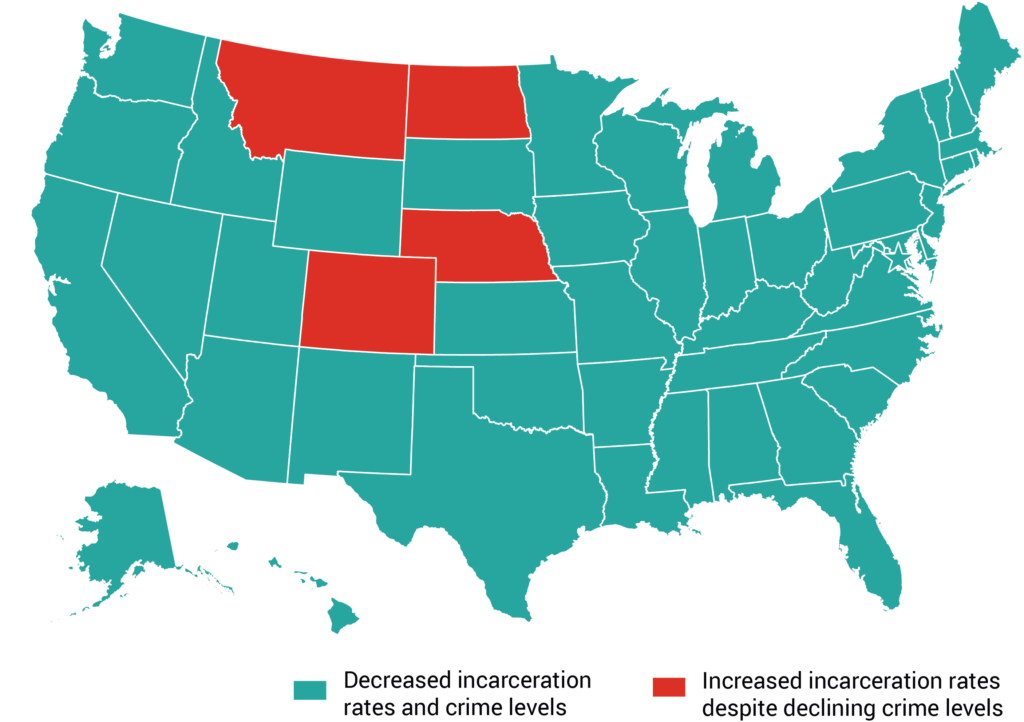
The Sentencing Project released a new research brief, “Incarceration & Crime: A Weak Relationship,” highlighting how 46 U.S. states have reduced both incarceration and crime levels in the past decade.
View the report here.
Juvenile Court Statistics 2021 Report
The National Center for Juvenile Justice has released “Juvenile Court Statistics 2021.” This report describes delinquency and petitioned status offense cases handled in U.S. courts with jurisdiction over juvenile populations between 2005 and 2021. Access the report here.
When Your Child Is Missing: A Family Survival Guide, Fifth Edition
The guide can be found here, with HTML and PDF downloads available.
“Left to Die in Prison: Emerging Adults 25 and Younger Sentenced to Life without Parole”
The Sentencing Project released a report that finds a large portion of people sentenced to die in prison were emerging adults 25 and younger when sentenced to life without parole (LWOP), despite irrefutable evidence that their younger age contributes to diminished capacity to comprehend the risk and consequences of their actions.
“Left to Die in Prison: Emerging Adults 25 and Younger Sentenced to Life without Parole” finds that the peak age at conviction for people sentenced to LWOP was 23-years-old, falling well within the period of emerging adulthood. Emerging adults share many key developmental characteristics with adolescents under age 18. Despite their serious crimes, these individuals have tremendous potential for growth and opportunity
U.S. courts have ruled that people under 18 should be protected against the cruelest sentences because of limits in their brain development. The report authors recommend extending this understanding to the full class of individuals who fall into this stage of development. Specifically, we recommend that the U.S. eliminate the use of LWOP and impose a sentence cap at 15 years for people 25 and younger.
How Youth Incarceration Undermines Public Safety: Reviewing The Evidence
by The Annie E. Casey Foundation:
https://www.aecf.org/blog/reviewing-the-evidence-how-youth-incarceration-undermines-public-safety
Explains the issues with incarceration and the ways it affects a youth in their daily lives. Also discusses ways to reduce the incarnation of youths. Read the article HERE.
Why Youth Incarceration Fails: An Updated Review of the Evidence
By Richard Mendel:
The article argues that incarceration is ineffective in reducing crime and ineffective in reforming juveniles. List the reasons why incarceration does more harm to juveniles than reform as well as ways to tackle this issue. Read the article HERE.
NJ’s AG Announces New Programs Aimed to Improve Police Interactions With Juveniles
By metrostaff :
The New Jersey Attorney General announced new strategies and programs to help interactions with juveniles and any youth that are likely to commit crime. This provides conversations on mental health, alternative ways to arrest a youth, role-playing scenarios a youth could get into, etc. Read the article HERE
Watchmen – Community Talks Library
Click to find all of NJPC's Watchmen Community Talks
Youth Partnership: A Call to Action for State Advisory
The Coalition for Juvenile Justice (CJJ) released a new guide on authentic youth engagement through relationships with youth members. Youth Partnership: A Call to Action for State Advisory Groups highlights ways that State Advisory Groups can form new partnerships with youth, further develop their existing relationships with youth, and ensure youth voices are being heard.
NEW REPORT FROM THE SENTENCING PROJECT: Diversion: A Hidden Key to Combating Racial and Ethnic Disparities in Juvenile Justice
The Sentencing Project is pleased to share our new report, “Diversion: A Hidden Key to Combating Racial and Ethnic Disparities in Juvenile Justice,” available here: https://www.sentencingproject.org/publications/diversion-a-hidden-key-to-combating-racial-and-ethnic-disparities-in-juvenile-justice/
And please take a look at the early media coverage on the study from JJIE and the Crime Report.
The report, authored by Senior Research Fellow Richard A. Mendel, examines decades of research showing how educational, career, and public safety outcomes are better for youth diverted away from juvenile courts. It provides a primer on diversion and its impact on racial equity. Specifically, the report shows that:
- Compared to youth who are formally involved in court, youth diverted from court have far lower likelihood of subsequent arrests, are far less likely to be incarcerated, commit less violence, have higher rates of school completion and college enrollment, and earn higher incomes in adulthood.
- Disparities in diversion result both from subjective biases against youth and families of color, and from seemingly neutral diversion rules and practices that cause disproportionate harm to youth of color either by unnecessarily limiting eligibility for diversion or making it difficult for youth of color to complete diversion successfully.
- A number of states and localities in recent years have adopted new strategies to expand and improve diversion, many of which show substantial promise.
However, efforts to expand diversion opportunities to date have most often lacked an explicit and determined focus on reducing racial and ethnic disparities – an essential ingredient for success. We’re eager to hear your ideas about how to expand the use of diversion in your states!
NJPC Watchman – April 2022 Edition
New Jersey Legislators must hold the Juvenile Justice Commission (JJC) and Department of Corrections (DOC) accountable for its treatment of youth.
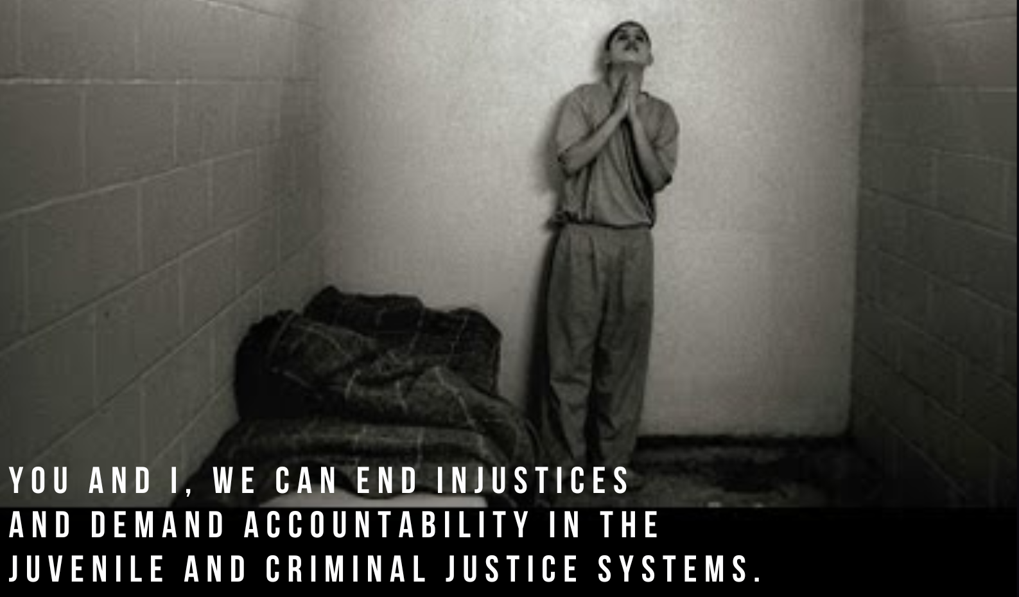
Annually, over 53,000 youth are prosecuted and sentenced as adults in the United States, a practice that research has shown is tremendously harmful to young people and that undermines public safety.
New Jersey law mandates that youth waived to the adult prison system must be protected from solitary confinement and should be given the opportunity to be incarcerated in a juvenile prison until the age of 21. Yet New Jersey children who are tried as adults continue to be subjected to inhumane conditions such as solitary confinement, regardless of their mental health status, and are incarcerated in an adult prison upon sentencing, regardless of their age. Please join the New Jersey Parents’ Caucus and other organizations throughout the state and country in demanding a legislative hearing to investigate the state’s noncompliance with laws that protect youth in adult prisons.
In 2015 and 2019, New Jersey passed the following provisions aimed at reducing the number of youths sent to adult prisons and increasing protections for children:
o Increased the age a child can be waived to adult court from 14 to 15 years old,
o Limited the scope of offenses that could result in a child being sent to adult court,
o Created a presumption that children waived to adult court should remain in youth facilities until they reach the age of 21, unless good cause is shown; Public Law 2015, C. 89.
And
o Expressly prohibited the use of solitary confinement for people under the age of 21, over the age of 65, individuals with disabilities, pregnant women, and those who identify as LGBTQ; Public Law 2019, C. 160.
These reforms were created to protect our children by reducing exposure to harm and increasing access to restorative programming.
However, the Juvenile Justice Commission, Department of Corrections, and the State of New Jersey has failed to comply with these laws according to first-hand accounts from parents, caregivers and NJPC Youth Caucus members who are currently incarcerated:
o A New Jersey Parents’ Caucus (NJPC) Youth Caucus member, Samuel, reports being waived into the adult court system at the age of 17 and incarcerated in an adult prison at the age of 19. According to the law, he should be held in a juvenile facility until the age of 21 unless good cause is shown. The JJC has not provided that data on their website as required by the law. In addition, Sam is one of over 200 youth who have been placed in an adult prison immediately upon sentencing.
o James, NJPC Youth Caucus member, was waived and incarcerated in the adult prison system at the age of 16 and sentenced at the age of 19. For the past 11 months, James and his mother report him being held in solitary confinement despite having four documented mental health diagnoses. As a member of a vulnerable population, he should NEVER be subjected to solitary confinement. He describes the barbaric living conditions of being locked in a room for 23 hours a day, stating that the rooms are falling apart with rats and bugs everywhere, and showers are only allowed once every three days.
We can no longer be quiet and wait for someone to ensure accountability of our legal system! Youth like James in vulnerable populations who struggle with mental health disorders continue to experience more than 60 consecutive days in solitary confinement.
Youth are experiencing inhumane living conditions and the Juvenile Justice Commission is sending most of the kids under the age of 21 to the adult prison system. New Jersey’s Juvenile Justice Commission and Department of Corrections are NOT complying with the law!
Sign our petition to demand that the Senate and General Assembly of the State of New Jersey schedule an investigatory hearing in order to hold New Jersey’s Juvenile Justice Commission and Department of Corrections accountable for these injustices!
You can sign our petition at the following link: https://chng.it/jThsxQp7mY
NJPC WATCHMEN – A Community Talk – March 15th Edition
Inmates throughout the state of New Jersey are constantly victims of inhumane treatment. John, a member of the NJPC Youth Caucus, recently reached out to tell us about the current conditions in New Jersey prisons.
Prisoners have the right to read, under the First Amendment. At times, that right is restricted if the book of choice is thought to have no penological purpose. Inmates are not allowed to read books that include information on anything that might create disorder in a prison or create a dangerous environment. Some of these titles include “48 Laws of Power” and “How to Hustle and Win.” John, however, tells a different story. “We are not allowed to order books that are not of their liking regardless of whether it’s on the ban list or not.” Denying youth who are currently incarcerated the ability to read is cruel and inhumane. It goes against their First Amendment right.
John also talks about the other violations happening behind bars. “Since being here I have been warning officers as well as staff about coming to work sick after testing positive with covid. None of them wear their mask unless a major or admin walks through. We have recently been strip searched in the middle of the last wave of covid because a sgt. didn’t like how the unit looked when she walked in.” This is particularly alarming, considering New Jersey had one of the highest inmate deaths due to Covid in the entire nation in 2020.
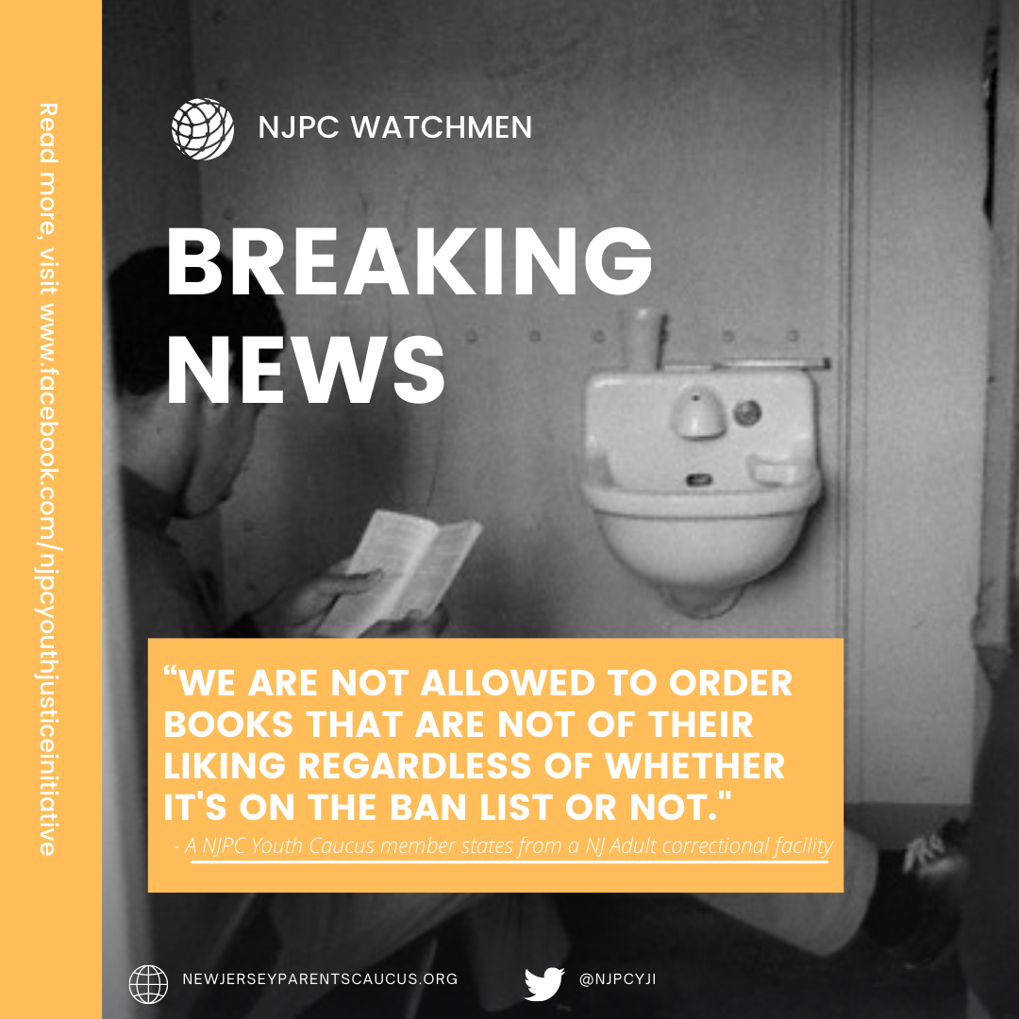
NJPC Watchmen – Community Talk March 1st Edition
NJPC Watchmen – A Community Talk
NJPC WATCHMEN – “I don’t wanna die from Covid”
Responding to Assault Charge at Youth Prison, Institute Renews Call for Closure
Read the article HERE
Victories for NJ’s Young People & Democracy!
The New Jersey Assembly passed S896/A2396, a bill to make public defender services free for youth under 18 – an issue highlighted in the Making Them Pay report by the Institute’s Camden Youth Council. Youth should never have to pay to defend themselves against criminal charges. The bill had already passed in the Senate, so it is now on its way to Gov. Murphy’s desk.
SMA Creatives LLC
Starcia Ague is helping make the world a better place with her activism and art. She is a true visionary who has made a career of lifting up others. The movement she started resulted in Washington State completely rethinking it’s approach to Juvenile Justice. Moreover, through her efforts, formerly incarcerated people around the nation have found their voices and influenced policymakers to make transformative changes to the criminal justice system. Starcia can always be counted on to be authentic and empower other individuals and organizations to achieve their full potential.
New Report Examines Ways To Support Students Entering and Transitioning Out of Juvenile Detention
Today, the Center for American Progress released a new report examining the administration and state of educational supports for students in the juvenile justice system as well as what supports exist to help students transitioning out of detention.
The report includes a 50-state analysis of which entities govern education for students in juvenile detention, whether there is a clear education continuum for students entering and exiting juvenile detention, and who governs the aftercare process to reintegrate students. The report’s findings also draw from discussions with incarcerated students detailing their experiences during the pandemic and providing feedback on the supports they need for a successful transition from detention to their communities. These conversations revealed that changing learning environments, a lack of mental health supports, and weak connections between detention facilities and the schools they returned to complicated efforts to ensure that their needs were met—increasing the risk of recidivism.
To address these challenges, the report includes recommendations for policymakers to support students transitioning from the juvenile detention back to schools in their communities, including how state and local education agencies can utilize funds provided by Congress under the American Rescue Plan to advance these efforts.
“To slow the spread of COVID-19, many juvenile detention facilities released students, and courts were discouraged from detaining additional youth. This increased the number of justice-involved students returning to their communities and underscores the need to invest in their successful reentry to the classroom. This report identifies key challenges standing in the way of that effort and offers urgent recommendations for policymakers to support justice-involved students in their moment of greatest need,” said Bayliss Fiddiman, associate director for K-12 Education Policy at CAP and author of the report.
Read the report: “How To Increase Support for Youth Leaving Juvenile Detention Facilities” by Bayliss Fiddiman
For more information on this topic or to speak with an expert, please contact Colin Seeberger at cseeberger@americanprogress.org or 202-741-6292.
Adam X v. NJ Departments of Corrections and Education
The ACLU of New Jersey and its co-counsel Disability Rights Advocates and Proskauer Rose LLP filed a federal class action lawsuit against the New Jersey Department of Corrections (NJDOC) and Department of Education (NJDOE) for failing to provide a free, appropriate, public education to students with disabilities in adult prisons, in violation of the Individuals with Disabilities Education Act (IDEA), Section 405 of the Rehabilitation Act, and the Americans with Disabilities Act. The lawsuit sought a comprehensive remedial plan and monitoring to ensure that eligible students are identified, and appropriate services are provided.
In May 2017, the Court appointed a neutral expert to review and evaluate the NJDOC’s provision of special education – and the NJDOE’s oversight of it – in order to recommend solutions. Following submission of the Court-ordered expert report in 2018, the parties engaged in three years of settlement negotiations.
In July 2021, the parties signed a settlement agreement requiring the adoption of new policies by the NJDOC and a robust monitoring role for the NJDOE, supported by a Court-appointed External Monitor, for a period of five years. The settlement agreement also provides for the establishment of a compensatory education program.
The case is captioned Adam X., et al. v. New Jersey Department of Corrections and Department of Education, et al.
Status
On July 21, 2021, the Court granted preliminary approval of the settlement agreement and certified the class. The class includes people who were incarcerated in NJDOC custody any time on or after January 11, 2015, and were or should have been identified as being entitled to special education services. It also includes anyone who entered custody under age 18, and without a high school diploma, during those years. It is estimated that the agreement impacts over 400 class members.
As part of the notice plan approved by the Court, class members will be contacted with information about the settlement agreement. Class members and others interested can read the Notice in the hyperlinked documents below, which also contains information on submitting objections and compensatory education forms.
A Fairness Hearing is scheduled before the District Court on January 26, 2022.
To file an objection, submit a completed compensatory education form, or request more information, please use the following address: ACLU of New Jersey, Attn: Class Action, P.O. Box 32159, Newark, NJ 07102. Requests for information may also be submitted via email and telephone as provided in the One-Page Flyer (PDF) and Full Notice Package (PDF).
Related Content
- Adam X: Amended Complaint (176 KB pdf)
- Adam X: Settlement Agreement with Exhibits (2.0 MB pdf)
- Adam X: One-Page Flyer (113 KB pdf)
- Adam X: Full Notice Package, including Compensatory Education Form (339 KB pdf)
- Adam X: Order Granting Preliminary Approval and Certifying Class (181 KB pdf)
- Adam X: NJDOC Policies – SFEA Student-Inmate Intake: Records Requests and Enrollment (2.1 MB pdf)
- Adam X: NJDOC Policies – Special Education Procedural Safeguards (634 KB pdf)
- Adam X: NJDOC Policies – Special Education Staff Qualifications & Development (1.9 MB pdf)
- Adam X: NJDOC Policies – Student Records: Discharge & Receipt of Records (1.3 MB pdf)
- Adam X: NJDOC Policies – Makeup Instruction for Special Education SFEA Student-Inmates & Scheduling Form (1.7 MB pdf)
- Adam X: NJDOC Policies – Educational Transition Planning for SFEA Students (227 KB pdf)
- Adam X: NJDOC Policies – Manifestation Determination (520 KB pdf)
Press Releases
- August 11, 2021: Court Preliminarily Approves Landmark Settlement That Improves Special Education Services in New Jersey State Prisons
- January 11, 2017: Incarcerated Students with Disabilities Sue New Jersey Over Denial of Education





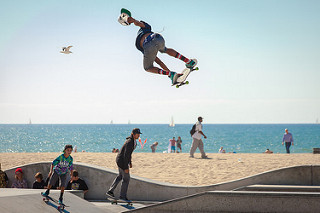


Search for:
Recent Posts
- NJYJI
- Calling All Caregivers and Parents!
- Torture By Another Name: The Use of Solitary Confinement on Youth and Young Adults in New Jersey Prisons
Recent Comments
- situs nova88 on Alina Lodge
- agen nova88 on Alina Lodge
- Pamela Davis on The Effects of NJPC Professional Parenting Advocacy Training on Children’s Mental Health in N.J.
Search for:
Recent Posts
- NJYJI
- Calling All Caregivers and Parents!
- Torture By Another Name: The Use of Solitary Confinement on Youth and Young Adults in New Jersey Prisons
- Police-Free Schools Resource
- Complete a Survey to Identify the Training Needs of Juvenile Services Staff
Recent Comments
- situs nova88 on Alina Lodge
- agen nova88 on Alina Lodge
- Pamela Davis on The Effects of NJPC Professional Parenting Advocacy Training on Children’s Mental Health in N.J.
- DanaVann on The Effects of NJPC Professional Parenting Advocacy Training on Children’s Mental Health in N.J.
- Fredro on Am I Going to Die in Prison?
Torture By Another Name: The Use of Solitary Confinement on Youth and Young Adults in New Jersey Prisons
In 2011, the United Nations Special Rapporteur on Torture deemed the use of solitary confinement against youth and individuals with mental health disabilities as torture.
Police-Free Schools Resource
Our recent publication, “Police-Free Schools,” discusses jurisdictions across the country that have removed police from schools as well as some information regarding the advocacy that led to these wins and what resources have been put in place in the wake of their removal. I’d be happy to connect you with some of these advocates as well if that would be helpful.
Melissa Coretz Goemann, Esq.
Senior Policy Counsel
National Juvenile Justice Network
Bring Our Kids Home: Lessons Learned from Covid-19 Decarceration Strategies
Hello & thank you for joining NJJN for our recent webinar:
You can watch the replay on YouTube below.
Got questions or want to stay in touch with NJJN? Sign up for our email list or reach out to us at info@njjn.org!
Commentary: Arresting young children is cruel, damaging and ineffective
New Report Rates Each State On Its Juvenile Justice System
FORUM 2020: A VISION FOR TRANSFORMING JUSTICE

2020 has been a year of pandemics, of uprisings, of tackling racism head on and planting seeds of transformation. To that end, we at NJJN aimed to cultivate content highlighting our members’ work across the country to deconstruct the systems that harm young people and offer a new vision for youth justice that leads with equity and humanity. The New Jersey parents caucus, a member agency of NJJN, encourages you to watch, learn, and engage with the below content to learn innovative strategies and actions you can take to build a brighter future for our youth.
NJPC Youth Caucus members and Executive Director participate in National Juvenile Justice Network 2020 forum (https://www.njjn.org/article/virtual-forum-2020—agenda)
Access the Virtual Forum HERE
REDUCING YOUTH ARRESTS DIVERSION
PREVENTION AND PRE-ARREST DIVERSION:
AN NJJN POLICY PLATFORM INFORMED BY YOUNG JUSTICE LEADERS
From the National Juvenile Justice Network. Read the document HERE
Black Lives Matter: Eliminating Racial Inequality in the Criminal Justice System
What is Black Lives Matter?
Black Lives Matter is a global organization whose mission is to dismantle white supremacy and bring awareness and change into the local systems (ex. police) that continuously affect Black communities. The organization also focuses on creating a space for Black people to showcase their innovations, share their imaginations, aspirations and their joy, whether it’s through their communities or their passion. For more information, click here: blacklivesmatter.com
What is Black Lives Matter’s involvement with the Criminal Justice system?
People of color, specifically Black/African Americans, make up a great percentage of the incarceration rate in America. Nazgol Ghandnoosh, Ph.D., Research Analyst at The Sentencing Project wrote a report in 2014 explaining the racial inequality in the criminal justice system. Some of the information that Dr. Nazgol Ghandnoosh provides are the causes of racial disparities in the criminal justice system, its outcomes and best practices for reducing racial disparities. Since the Black Lives Matter organization’s mission is to combat and counter any acts of violence against black communities, the criminal justice system has a history in mistreating and racially profiling black individuals. This has contributed to the increase in the incarceration rate of Black people.
For more information, click here: Black Lives Matter: Eliminating Racial Inequity in the Criminal Justice System.
Additional Links to get informed on the movement:
How Student Activism Shaped The Black Lives Matter Movement. (Forbes.com)
Black Lives Matter: A Curated Collection of Links. (Marshall Project)
NJ Silent Mental Health Crisis & The School To Prison Pipeline – Advocates for Children of New Jersey & NJPC
Click through to view the video.
Familes’ Coalition of Justice Involved Youth
Open to parents, caregivers, and family of youth involved in the justice system interested in reforming the juvenile justice system in New Jersey. Registration is recommended, as food will be served.
Souls of Young Folk Report
Youth Justice Action Month is Here!
On October 1, YJAM (Youth Justice Action Month) begins again. Since 2008, youth justice advocates around the country have come together to organize events and online activities to raise awareness and inspire action on behalf of young people impacted by our criminal justice system.
This year, we note that since CFYJ opened, more than 100 pieces of legislation have been passed that have reduced, restricted, or ended the trial, incarceration, or sentencing of children in adult courts. But we also note that racial and ethnic disparities inherent in the system have not improved – more clear evidence that racism remains a centerpiece of our justice system.
Read More HERE
Alternatives to Adult Incarceration For Youth
WASHINGTON (April 17, 2019) — In an effort to identify alternatives to adult incarceration for youth, the Campaign for Youth Justice (CFYJ) is learning from stakeholders across the country about their efforts to serve youth charged as adults across a continuum of care. In a new report, “If Not The Adult System,Then Where? Alternatives to Adult Incarceration For Youth Certified Adults”. CFYJ shares current and emerging practices for better serving youth charged as adults, insights from practitioners about what makes for successful programming for this population, and specific recommendations for policy and practice change.
New Report Questions New Jersey’s Juvenile Justice System / NJTV New
By Erin Delmore
Correspondent
“Youth prisons are failing our children in this state, but particularly our children of color,” explained Andrea McChristian from the New Jersey Institute for Social Justice.
If you take a look inside New Jersey’s juvenile justice system you’ll see the racial disparities laid bare. Seventy-five percent of incarcerated kids are black. That gap among races is the third-highest in the country.
McChristian said, “The research shows that a black kid in New Jersey is 24 times more likely to be sentenced to confinement than a white child. And this starts at arrest where black kids are more likely to be arrested. They’re less likely to be diverted and they’re more likely to end up in our state’s youth prisons.”
It’s a trend that’s existed for decades, and while the issue is getting more attention these days, the stats remain the same, according to a new report by the New Jersey Institute for Social Justice. McChristian is its lead author.
She said, “It’s not because black kids are somehow more criminally culpable than white children. Actually, there are few differences between black kids and white kids in terms of delinquent behavior, in terms of committing status offenses — which are offenses that are only criminalized if you’re a minor, like underage drinking. So this is actually about policy.”
Fred Fogg is the regional director of operations for New Jersey and Delaware at Youth Advocate Programs. He works to engage kids and their families in community-based alternatives to jail time. At around $75 a day, those alternatives run at just a fraction of the cost of full-time confinement which can hit above $500 a day — nearly $200,000 a year per person.
Fogg said, “Most of the youths that are incarcerated are for nonviolent offenses.”
Fogg says alternative programs that keep kids in the community cut down recidivism rates. As it stands now, three out of four kids are re-arrested. Nearly half land themselves back in jail within three years.
“White youth involved in juvenile justice issues tend to have better access to diversion programs than African American youth,” Fogg said.
The number of incarcerated kids in New Jersey has fallen by half over the last two decades as some offenders found their way to diversion programs. But according to the report, that just widened the gap between black and brown and white.
“When we look at young black boy or a young Latino boy. What do we think about them? Do we really believe that the prison is the best place for them to be in? Is that where we are truly going to rehabilitate them?” questioned Kathy Wright of the New Jersey Parents Caucus.
“We need to start realizing that these are children. That the research has show that the adolescent brain is still developing and that deviant or anti-social behavior peaks at age 16 and 17 and then declines as a child matures, but we aren’t thinking that. We aren’t thinking that ok locking a kid away who is honestly going to age out of this type of behavior, doesn’t make sense,” said McChristian.
Fogg said, “They’ve gone in these facilities as children and they’re coming back chronologically as adults, but they’re not developing into men in correctional facilities. They’re on pause for the most part.”
With a new administration taking shape, McChristian says she expects reform at the federal level to come slowly. Instead, her organization is looking toward local and state level policy changes which have proven effective, in New Jersey, when it comes to bail reform and reentry initiatives.
The Incarceration of Children and Youth in New Jersey’s Adult Prison System
View the attached file
NJPC-The-Incarceration-of-Children-and-Youth-in-NJ-Adult-Prison-SystemGetting to Zero
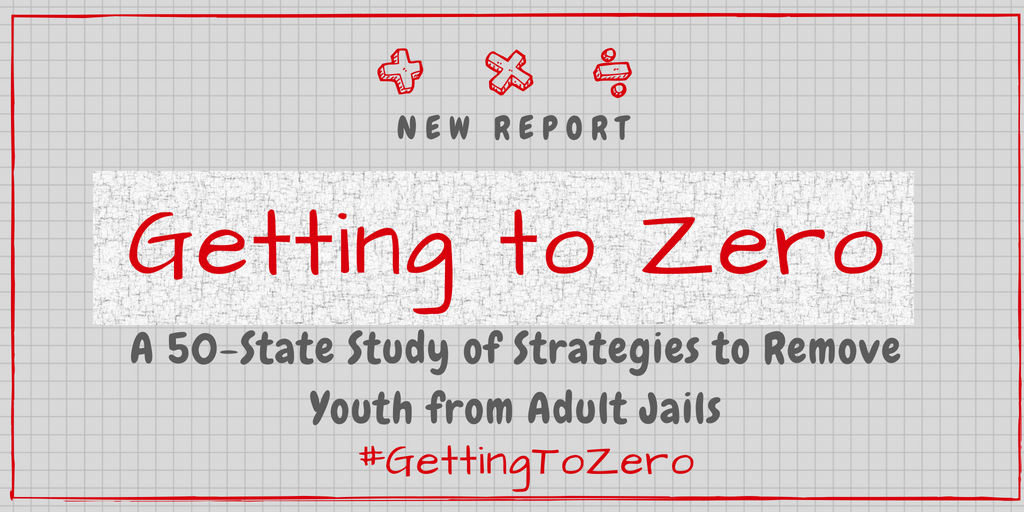
WASHINGTON (Aug. 28, 2018) — With adult jails housing an increasing number of state prisoners, and the population within juvenile detention facilities shrinking, now is the time to reassess the way youth prosecuted as adults are incarcerated in America.
An overwhelming amount of research shows that the adult criminal justice system is ill-equipped to meet the needs of youth, from trial to incarceration and re-entry. Beyond what brain science reveals about adolescent development, the adult criminal justice system does not reduce recidivism and often leaves youth at risk of abuse.
- Youth in adult jails are at extreme risk of suicide. Every year since 2010, an average of three children have died in adult jails; two out of three by suicide. Youth under the age of 17 in adult jails have a mortality rate nearly twice that of young adults (18-24-year-olds) in adult jails, 9 times higher than youth in the general population, and 36 times more likely to commit suicide in an adult jail than in juvenile detention facility.
- Many jails are holding youth in solitary confinement. More than half (54%) of jails housing girls, and almost a third (31%) of jails housing boys reported housing only a single youth at the time.
- Youth in adult jails are at extreme risk of sexual abuse by jail staff and other inmates, even during brief detention stays: 15% of sexual abuse victims in jails report having been abused by another inmate within the first 24 hours of their arrival at the jail. In fact, sexual abuse by staff in jails is the highest for the youngest inmates (3.3%). Some populations of youth are particularly vulnerable – girls have higher rates of sexual abuse compared to boys (4.4% compared to 1.6%); white youth have higher rates of abuse than black and Latino youth (6.6% versus 1.1%); and youth who are sexual minorities (e.g., LGBT youth) have higher rates of abuse than heterosexual youth (6.3% versus 1.7%).
A new report, “Getting to Zero: A 50 State Study of Strategies to Remove Youth from Adult Jails,” analyzes national data sets and state laws to provide concrete policy change recommendations to remove youth from adult jails across the country.
Although the number of youth in adult jails has declined over 50 percent since a recent peak in 2010, between 32,000 and 60,000 youth are estimated to enter adult jails every year.
Getting to Zero provides the first-ever analysis of three nationwide datasets – the Bureau of Justice Statistics’ (BJS) Census of Jails and Annual Survey of Jails, and the Office of Juvenile Justice and Delinquency Prevention’s Census of Juvenile Residential Placements – to examine how youth currently housed in adult jails can be safely housed in juvenile facilities. Second, it summarizes the major legal developments applicable to youth housed in adult jails. Third, it provides specific examples from jurisdictions across the country which have made substantial progress toward removing youth from adult jails.
Neelum Arya, study author explains, “For the first time we have data to show exactly where youth are incarcerated in adult jails in America, the legal analysis to explain why it happens, and examples of what policymakers can do to remove youth from jails altogether.”
According to the report, each of the 50 States and Washington D.C. has at least one of six types of transfer laws, and one of three types of jail laws, leading to nearly 1,000 possible explanations of the legal basis for why youth end up incarcerated in adult jails. Yet the analysis of the 2013 Census of Jails data from the Bureau of Justice Statistics shows that almost 90 percent of youth housed in adult jails were held in just fifteen states: Alabama, Arizona, Florida, Georgia, Louisiana, Indiana, Maryland, Michigan, Missouri, New York, North Carolina, Pennsylvania, South Carolina, Texas, and Wisconsin.
The majority of children appear to be incarcerated in adult jails due to: age of juvenile court jurisdiction laws which require all 17-year-olds to be prosecuted in the adult system, colloquially known as “raise the age”; automatic transfer laws which require youth under certain circumstances to be prosecuted as adults; and state jail laws which require youth prosecuted as adults be held in adult facilities pre-trial.
Where youth are not held in adult jails is equally telling. Although most state statutes allow youth to be held in adult jails, in practice, juvenile facilities are being used to house youth who otherwise would be incarcerated with adults in many states. Three of the most populous states in the country, California, Illinois, and Ohio, all have state jail laws which allow youth to be housed in adult jails under certain circumstances, but none of these states have large numbers of youth in jails. This is true even for Los Angeles and Cook County, two jurisdictions with significant gang and gun violence.
The report also provides an overview of positive changes that have taken place and identifies specific strategies states can use to remove youth from adult jails. Since 2009, 20 States and the District of Columbia have passed laws which have started to limit the admissions to, or remove youth from, adult jails.
- The single most significant strategy in the effort to remove youth from adult jails is “Raise the Age” legislation. More than half (54%) of the youth incarcerated in adult jails can be removed as part of the implementation of this legislation in nine states. Louisiana, New York, North Carolina, Missouri, and South Carolina are in the process of implementation. Georgia, Michigan, Texas, and Wisconsin still need to pass this type of law.
- The second most important strategy in the effort to remove youth from adult jails are efforts to change the state transfer law through modifying statutory exclusion laws which automatically exclude a youth from the juvenile justice system.If six states – Alabama, Arizona, Florida, Oklahoma, Maryland, and Pennsylvania – were to change their transfer laws and jail laws to prohibit youth from being held in adult jails at arrest, the population of youth in adult jails could be reduced by an additional 26%.
- Every State which currently allows youth to be housed in adult jails should consider updating their jail law to ensure youth are only housed in adult jails in the rarest of instances. There are several states – notably Arizona, Florida, Maryland, Oklahoma, and Wisconsin – where the text of the state jail law requires that youth must be held in an adult jail under certain circumstances. If these 5 states were to change course and go from requiringto prohibiting housing youth in adult jails, the number of youth incarcerated in adult jails would drop by 21%.
- In addition to state-level reforms, city and county officials should pass specific ordinances and develop internal county policies to include presumptions that youth tried as adults are detained in juvenile facilities.Although large urban jails holding large numbers of youth dominate the conversations about youth in adult jails, most counties and jails hold few youth at a time which the report shows could be accommodated in other juvenile facilities. If counties which held less than 9 youth at a time found other placements for these youth, the number of youth incarcerated in adult jails would drop by 33%.
The report provides recommendations for policymakers at the federal, state, and local level; jailors and juvenile detention administrators; prosecutors and public defenders; and advocates all have a role to play to assist in Getting to Zero.
Supporting Immigrant Youth Caught in the Crosshairs of the Justice System.
NJPC New Jersey Youth Justice Initiative (NJYJI)
NJPC New Jersey Youth Justice Initiative (NJYJI) is a grassroots family and youth-driven justice program, which seeks to improve outcomes for justice-involved youth and ensure leadership opportunities for youth and family members on all levels of decision making.
NJYJI represents a new frontier in the family movement, as it establishes a formalized support network for families raising justice-involved youth. With the support of our Parents Coalition of Justice-Involved Youth and the NJ Youth Caucus, NJPC provides peer advocacy to parents, family members and youth throughout the state, free legal services clinic, and professional parent advocacy training and education. In 2014, NJPC received a state spotlight and was highlighted by the National Juvenile Justice Evaluation Center (NJJEC), identifying NJPCs extensive program data collection that spans more than 30,000 training hours delivered to family members, professionals and providers. The data collection showed parental improvements in the utilization of mental health and special education services, declines in the involvement of youth in the juvenile justice system, and demonstrated reductions of family involvement in the child welfare system.
Through various venues, NJPC has advocated for safe alternatives to incarceration for troubled youth and improved conditions for youth who must be confined. We continue to work to expand an understanding of policies and practices that can put youth on a path to productive adulthood — a result that is good for both children and our state.
NJPC is a steering committee member of the Youth Justice New Jersey Coalition, which is working to reduce the number of incarcerated youth; promote rehabilitative community-based alternatives to incarceration; ensure incarcerated youth are free from abusive practices and that they receive quality services and education; end school policies and practices that push youth out of classrooms and into the criminal justice system; and eliminate disparate treatment of youth of color in the juvenile justice system. To learn more about the coalition, contact Pamela DeLeon at pamelad@njparentcaucus.org
Am I Going to Die in Prison?
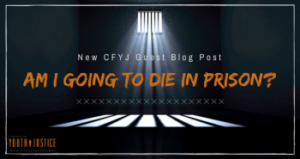
By Jamal Lewis, New Jersey Parents’ Caucus
“Am I going to die in prison?” I was arrested and charged with committing my offenses at the age of 16. I was transferred into the adult criminal justice system at the age of 17. I had none of the assistance available to youth serving their sentence in a youth facility, where young people were offered rehabilitation and vocational training. There were no therapeutic or vocational programs in New Jersey State Prison, where I served the first 11 years of my sentence.
The enactment of the Violent Crime Control and Law Enforcement Act signed into law by former President Bill Clinton in 1994 banned federal financial aid, like the Pell Grant, for Higher Education programs within state and federal prisons. Therefore, post secondary education courses were no longer an option for me, and my education stopped after I acquired my G.E.D. in 1998, almost 20 years ago. To date, I have been in administrative segregation (solitary confinement) over 10 times. I have struggled to learn social and civic responsibility without any meaningful assistance.
Since my incarceration, New Jersey raised the minimum age that a youth may be transferred to adult court, former Governor Christie signed a law banning life sentences without parole for juveniles in 2017, and the New Jersey Supreme court ruled in State v Zuber (2016) that courts could not sentence juveniles to a term defined as the “practical equivalent of life without parole.” There are many currently incarcerated, like me, who received their sentences prior to these changes, who are not afforded their benefit, which begs the question: “Am I going to die in prison?”
I am not familiar with an excess of cases where offenders serving life with 30 years parole eligibility, who have been to a parole hearing where he or she was granted release. However, the few that I am aware of who were tried as adults as juveniles and had parole hearings, have not only been denied parole, they have received an F.E.T. of 120 months (10 years) or more. There is neurological and developmental science and research that tells us youth are different than adults. There is a growing national consensus to change how youth are treated in the adult criminal justice system. Yet, these advances are not recognized by New Jersey’s Department of Corrections and some in our judiciary, particularly when it comes to the treatment of youth tried as adults before these reforms. I ask that reformers and advocates for youth locked in prisons don’t forget to advocate for those of us who have been in adult prison for decades and who have to ask ourselves everyday, “Am I going to die in prison?”
NEW GUIDE PREPARES JUVENILE OFFENDERS FOR REENTRY
Office of Justice Programs sent this bulletin at 07/30/2018 08:00 AM EDT
NEW GUIDE PREPARES JUVENILE OFFENDERS FOR REENTRY
WASHINGTON – The Office of Justice Programs’ Office of Juvenile Justice and Delinquency Prevention today released Reentry Starts Here: A Guide for Youth in Long-Term Juvenile Corrections and Treatment Programs, a toolkit to help youth prepare for return to their communities after confinement.
The publication covers steps youth can take to plan for reentry while they are in confinement, and steps they can take to overcome common barriers to reentry once back in their community, including how to request a school transfer, apply for housing, gain employment, and seek support services.
“This is a way to empower youth to advocate for themselves while also preparing for their lives post-release,” said OJJDP Administrator Caren Harp. “This guide helps them visualize their own success, to think through what steps they need to take to get their lives back on track and become productive members of their communities.”
The guide was specifically designed to be practical, and easily understood by detained youth, their families, and those assisting youth transition back into society, such as probation officers, counselors, and mentors. In short, the guide is meant to set incarcerated youth up for success before they are released, while also reducing the chances they will reoffend.
The guide is available at https://www.ojjdp.gov/pubs/251193.pdf
2017 NJJN Member Youth Justice Advances
In 2017, NJJN members were at the forefront of advancing major youth justice reforms in states and localities around the country. In this snapshot, we highlight a sampling of primarily legislative initiatives that were signed into law in 2017 and the NJJN members who pushed those reforms. A partial list of 2017 youth justice advances across the United States and in NJ are organized by topic it here.
Teens With Mental Disabilities Held in Solitary For Up to 23 Hours
It happened in New Jersey and is happening in Contra Costa County, in the San Francisco Bay Area. A class action lawsuit was filed in August 2013 by Berkeley-based Disability Rights Advocates, on behalf of a teenage girl and two boys, all of whom were or are still detained at a maximum-security, 290-bed juvenile hall in Martinez, Calif. At issue is Contra Costa County’s policy of locking disabled kids in solitary confinement, sometimes for months in a 12-by-12 foot cell. Attorneys for the federal Department of Justice and Department of Education ripped Contra Costa County officials in charge of juvenile hall for locking up youths in solitary confinement and refusing to school them during their punishment, saying they are violating the teens’ rights. The suit was brought against the county Probation Department and Contra Costa Office of Education.
Read more HERE.
Dr. Peter Langman offers a website and free public resource
Dr. Peter Langman offers a website and free public resource containing over 400 documents (totaling about 57,000 pages) relating to school shootings, school shooters and the prevention of rampage attacks HERE.
Dr. Peter Langman offers a website and free public resource
OVC is pleased to announce the release of the 2017 National Crime Victims Rights Week (NCVRW) Resource Guide. NCVRW will be commemorated April 28, 2017, and the resource guide promotes this year’s theme, ”Strength. Resilience. Justice.The Guide provides all the materials necessary to promote public awareness campaigns for NCVRW and throughout the year. Campaign materials include planning tips, artwork, crime and victimization fact sheets, and more. A Spanish version of the resource guide will be coming soon.
Juvenile Justice System Leaders and Families Agree on a Family-driven Approach to Juvenile Justic
WASHINGTON (May 6, 2013) – Today the Campaign for Youth Justice (CFYJ), an advocacy organization dedicated to ending the practice of trying, sentencing, and incarcerating youth under 18 in the adult criminal justice system, released a new report, Family Comes First: A Workbook to Transform the Justice System by Partnering With Families.
 The report is the first comprehensive analysis of current family engagement and family partnership practices in juvenile justice systems around the country and provides practical tools and resources to juvenile justice system practitioners in undertaking a family-driven approach to juvenile justice. “This report underscores the critical importance of involving families in juvenile justice,” says Liz Ryan, President and CEO of the Campaign for Youth Justice. “Family Comes First serves as a guide for juvenile justice system practitioners to implement a new, family-driven approach to juvenile justice. ”
The report is the first comprehensive analysis of current family engagement and family partnership practices in juvenile justice systems around the country and provides practical tools and resources to juvenile justice system practitioners in undertaking a family-driven approach to juvenile justice. “This report underscores the critical importance of involving families in juvenile justice,” says Liz Ryan, President and CEO of the Campaign for Youth Justice. “Family Comes First serves as a guide for juvenile justice system practitioners to implement a new, family-driven approach to juvenile justice. ”
The workbook was funded in large part by a generous grant from the Annie E. Casey Foundation. In partnership with the U.S. Department of Justice’s Office of Juvenile Justice & Delinquency Prevention (OJJDP), the Campaign for Youth Justice (CFYJ) conducted listening sessions with families impacted by the juvenile and criminal justice system. CFYJ also surveyed juvenile justice system leaders in juvenile corrections and juvenile detention and found that families and juvenile justice system leaders agree that:
- Basic information about the process of the court system, families’ legal rights, and the role of the various players in the system is not available to families and prevents effectively addressing any treatment needs of the child;
- Economic and social supports necessary to meet the needs of children are not available to families and prevent the full participation of families in the existing activities offered by the justice system;
- Justice systems and agencies are not staffed or resourced appropriately to effectively support families;
- An opportunity to participate in decision-making at all levels should be provided to families; and
- Family supports from other families and system staff will ensure that youth achieve positive outcomes.
Justice Denied: One Young Person’s Story
NJPC Youth Coalition Member D.M. writes about his life in New Jersey’s mental health, child welfare and juvenile justice system. Read the entire article HERE.
Most States Still House Some Youth in Adult Prisons, Report Says
WASHINGTON – Most states continue to house youth in adult prisons, putting them at risk for physical and sexual abuse, says a new report. But as the number of youth in both juvenile and adult facilities decrease, states have the chance to end the practice of housing youth in adult facilities entirely, said the Campaign for Youth Justice in the report.
Coordinating Access to Services for Justice-Involved Populations
States that expanded Medicaid coverage under the Affordable Care Act have unprecedented opportunities to connect adults released from prison or jail with needed physical and behavioral health services and social supports. This population – disproportionately male, minority, and poor – suffers from high rates of mental illness and substance use disorders. Providing critical health services and social supports for these individuals can potentially slow the revolving door of recidivism. Read the brief from CHCS HERE.
LOCKED OUT: Improving Educational and Vocational Outcomes for Incarcerated Youth
This issue brief highlights the key findings of a national survey conducted in partnership with the Council of Juvenile Correctional Administrators of all 50 state agencies, to better understand the extent states are currently providing incarcerated youth with access to educational and vocational services, tracking and using student outcome data, and supporting incarcerated youths’ school re-enrollment. The issue brief also provides state and local policymakers with policy and practice recommendations to improve college and career readiness for incarcerated youth, and examples of how select states have translated these recommendations into policy and practice. Read more HERE.
New Jersey Bill to Reform Youth Transfer, Waiver and Confinement Policies
he Bill will raise the age of adult court waiver, eliminate disciplinary confinement in the juvenile justice system, and ensure due process before youth can be transferred from juvenile to adult facilities. Read more HERE.
Childhood Interrupted
Watch the video
2015 State Legislative Sessions
An Update on Nationwide Juvenile Justice Reforms to Protect Youth from the Adult Criminal Justice System
In New Jersey, the Governor recently signed Senate Bill 2003. This bill includes numerous provisions that drastically improve juvenile justice in New Jersey. First, this bill increases the minimum age at which a youth can be tried as an adult from 14 to 15. Second, it limits the transfer and incarceration of youth under the age of 18, instead of the current lower limit of 16, to only those committing the most serious and violent of crimes. Third, this bill makes it more difficult for youth to be transferred to adult court, as prosecutors must submit written analysis on the reasons for the transfer, which is then granted only at the discretion of a judge. Finally, this bill tightens restrictions on the use of solitary confinement for youth. These reforms would signal a positive move towards justice for New Jersey youth, while also improving physical and mental well-being.
The Sentencing Reform and Corrections Act of 2015
This legislation was introduced by a bipartisan group of senators led by Senate Judiciary Committee Chairman Chuck Grassley and Assistant Democratic Leader Dick Durbin. Among other provisions, it would:
- end juvenile life without parole in the federal justice system by allowing youth sent to the federal system to seek parole after serving 20 years of their sentence;
- limit solitary confinement for youth in federal custody; and
- permit certain youth tried in federal court for nonviolent offenses to seal or expunge their records under certain circumstances.
Pipeline to Prison: How the Juvenile Justice System Fails Special Education Students
A special education student, Jennings qualified for extra help in school. Those services should have carried over to the justice system, but Jennings said he never even attended class while in jail. Now 20, he is still unable to read or write.Read HERE
Senate Judiciary Committee Approves JJDPA Update
WASHINGTON – A bipartisan bill that aims to strengthen protections for youth who enter the criminal justice system cleared a key congressional committee today. The Senate Judiciary Committee approved by voice vote the federal Juvenile Justice and Delinquency Prevention Reauthorization Act of 2015 (S 1169). The law, which is more than 40 years old, sets federal standards and supports for juvenile justice programs in state and local jurisdictions.
LOCAL ADVOCATE WINS PRESTIGIOUS FELLOWSHIP IN YOUTH JUSTICE
Fellowship Develops Emerging Professionals of Color in Juvenile Justice Reform
(Elizabeth, N.J) Kathy Wright, Executive Director of the New Jersey Parent’s Caucus, has been chosen to be a fellow in the Youth Justice Leadership Institute. The Institute is a prestigious national fellowship program run by the National Juvenile Justice Network (NJJN) in Washington, DC for juvenile justice reform advocates. Applications to the year-long leadership development program-which is targeted at emerging professionals of color-are competitive, and only ten people are selected each year. Read more..
Engaging Law Enforcement on Youth Justice Reform
What are some areas where youth justice advocates can work with law enforcement leaders to increase fairness and promote “Engaging Law Enforcement on Youth Justice Reform,” which focuses on some of the best starting points for collaborative work on reform.
NOTE: The update draws on a 2014 report from International Association of Chiefs of Police (IACP), produced with the support of the MacArthur Foundation.
‘Mad Mom’ Gets Significant Juvenile Court Win:
Experienced lawyers thought Christene Wood was out of her mind when she mounted an appellate challenge to a juvenile certification decision—a process that allows children as young as 14 to be tried as adults for felony offenses. Read more:
BILL WOULD REAUTHORIZE JJDPA & EXTEND ADDITIONAL PROTECTIONS TO YOUTH IN JUVENILE JUSTICE SYSTEM
Today, Senator Sheldon Whitehouse (D-RI) and Senator Chuck Grassley (R-IA) introduced a bill that aims to reauthorize the Juvenile Justice and Delinquency Prevention Act (JJDPA), our country’s broadest federal juvenile justice law.  The measure, which was first enacted 40 years ago–and last reauthorized in 2002–addresses four key issues for young people who are involved in the juvenile justice system: racial and ethnic disparities; holding youth in adult jails; separation of incarcerated youth and adults by both sight and sound barriers; and the incarceration of children for status offenses, e.g. skipping school, missing curfew, and running away from home.
The measure, which was first enacted 40 years ago–and last reauthorized in 2002–addresses four key issues for young people who are involved in the juvenile justice system: racial and ethnic disparities; holding youth in adult jails; separation of incarcerated youth and adults by both sight and sound barriers; and the incarceration of children for status offenses, e.g. skipping school, missing curfew, and running away from home.
“Reauthorization of the JJDPA is long overdue,” said Sarah Bryer, director of the National Juvenile Justice Network. “It gives crucial guidance to states on how to ensure their justice systems keep communities safe and protect children in trouble with the law. Yet the existing law hasn’t kept pace with what we’ve learned about how to do that, including new research on adolescent brain development and the efficacy — and fiscal soundness — of community-based alternatives as compared to incarceration.”
Reintroducing the JJDPA is an important step forward. This bill marks the first bi-partisan reintroduction of the JJDPA in five years. “We recognize that there is limited time left on the 2014 legislative calendar,” said Bryer. “We are hopeful that Senator Grassley will continue to see this issue as a priority when he assumes leadership of the Senate Judiciary
$400K awarded to settle lawsuit over solitary confinement of 2 N.J. boys
Mentally Ill juvenile was kept in isolation for at least 178 of the 225 days he was in the custody of the justice commission, the suit claimed. At one point, he was locked in his cell for 22 consecutive days, allowed out only for hygiene.
TRENTON – New Jersey’s Juvenile Justice Commission and Rutgers University have agreed to pay $400,000 to settle a federal lawsuit over the solitary confinement of two troublesome teenage boys who were locked away for long stretches while in state custody. Some advocates for children hope the case will become a flash point in the debate over solitary confinement. Corrections officials consider the practice a needed tool, while others say it makes it harder for juvenile detention centers to achieve their goal of helping kids get better. Read the article HERE.
Juvenile Justice Schools Do More Harm Than Good, Study Finds
Education programs in juvenile justice systems across the United States are not providing incarcerated youth with the skills and education they need to reenter school and society, a report from the Southern Education Foundation finds. The report,Just Learning: The Imperative to Transform Juvenile Justice Systems Into Effective Educational Systems, found that, instead of being helped to turn their lives around, the seventy thousand youth enrolled in juvenile justice education programs on any given day – nearly two-thirds of them males of color – are falling further behind. In 2009, for example, incarcerated youth who were enrolled for at least ninety days in a juvenile justice education program failed to make any significant improvement in learning and academic achievement. Incarcerated youth in smaller facilities near their communities actually made less progress than youth enrolled in state systems, especially in southern states, where the proportion of youth enrolled in local facilities increased from 21 percent in 2007 to almost 60 percent in 2011. Part of the problem, the study found, is that such programs provide limited support for youth with serious learning and emotional problems.
The study also highlights successful programs that use approaches that have proven to be effective for many high-risk students, as well as research on an innovative program in Chicago which demonstrates that cognitive behavior therapy resulted in a 44 percent reduction in violent crime arrests as well as improvement in school attendance, GPA, and persistence among participants.
“The juvenile justice education programs that serve hundreds of thousands of students are characterized by low expectations, inadequate supports to address student needs, and ineffective instruction and technology,” said Southern Education Foundation vice president Steve Suitts, who authored the study. “Students come out of the juvenile justice system in worse shape than when they entered, struggling to return to school or get their lives back on track.”
Bipartisan consensus on strengthening federal law to reduce incarceration, make state juvenile justice systems more fair, improve public safety
Youth, family and juvenile justice advocates endorse reintroduction of bill to support states efforts to improve their juvenile justice systems, protect kids, and build safer communities
WASHINGTON, D.C. (April 30, 2015) – Juvenile justice advocates across the country applaud Senator Charles Grassley (R-IA) and Senator Sheldon Whitehouse (D-RI) for the re-introduction of the Juvenile Justice and Delinquency Prevention Reauthorization Act of 2015, to reauthorize and strengthen the Juvenile Justice Delinquency and Prevention Act of 1974 (JJDPA). The bill is very similar to legislation introduced last December in the last days of the 113th Congress.
Signed into law by President Gerald Ford on September 7, 1974, and most recently reauthorized in 2002, the JJDPA embodies a partnership between the federal government and the U.S. states, territories, and the District of Columbia to protect children and youth in the juvenile and criminal justice system, to effectively address high-risk and delinquent behavior and to improve community safety.
More than seven years overdue for reauthorization, the JJDPA is the only federal statute that sets out national standards for the custody and care of youth in the juvenile justice system and provides direction and support for state juvenile justice system improvements. The JJDPA also supports programs and practices that have significantly contributed to the reduction of delinquency.
“We are grateful for Senator Grassley’s and Senator Whitehouse’s continued commitment to strengthening protections for our young people who are involved with the juvenile justice system,” said Marie Williams, Co-Chair of ACT4JJ and Executive Director of the Coalition for Juvenile Justice. “As expected, the new legislation tightens the accountability of states who receive funding under the Act and helps ensure that young people receive the protections, services, and supports they need.”
Despite a continuing decline in youth delinquency, more than 60,000 young people are held in detention centers awaiting trial or confined by the courts in juvenile facilities in the U.S. For these confined youth, and the many more kids at-risk of involvement in the justice system, the JJDPA and programs it supports are critical. Youth who are locked up are separated from their families and many witness violence. These youth struggle when they get out, trying to complete high school, get jobs, housing, or go to college. Aside from the human toll, the financial costs of maintaining large secure facilities have also made it vital to rethink juvenile justice in every community.
“The bill brings the JJDPA in line with what research tells us and states know-that incarcerating kids, particularly status offenders, and locking kids up with adults causes harm and does not reduce crime and delinquency,” said Marcy Mistrett, Co-Chair of ACT4JJ and Chief Executive Officer of the Campaign for Youth Justice. “This bill reaffirms a national commitment to the rehabilitative purpose of the juvenile justice system; one that supports developmentally appropriate practices that treat as many youth as possible in their communities. It is both cost effective and the morally right thing to do.”
Key provisions in include:
- Phase-out of the Loophole that Allows Status Offenders to Be Locked Up
While current federal law prohibits detaining youth for status offenses (like truancy and running away from home), youth can be ordered by a court not to do these things as a condition of release through a court order. Many youth are subsequently detained for technical violations of such a valid court order. Many states have already prohibited use of this exception – known as the VCO exception – in light of research that shows it is harmful to youth development and is costly, especially when compared to community-based alternatives. The bill calls on all states to phase out use of the VCO exception over the next three years.
- Strengthening of Protections to Keep Youth out of Adult Jails and Prisons
Research shows youth confined in adult jails and lock-ups are more likely to re-offend upon release and, while confined, are at pronounced high risk of suffering assault and committing suicide. The bill extends the jail removal and sight and sound core protections to keep youth awaiting trial in criminal court out of adult lock-ups and ensures sight and sound separation from adult inmates in the limited circumstances where they are held in adult facilities.
- Supports for State Efforts to Reduce Racial and Ethnic Disparities
The bill gives clear direction to states and localities to plan and implement data-driven approaches to ensure fairness and reduce racial and ethnic disparities, to set measurable objectives for reduction of disparities in the system, and to publicly report such efforts.
For more information go to www.ACT4JJ.org
Baltimore Sun Editorial on Youth Promise Act: Breaking a vicious cycle [Editorial]
Our view: Congress can begin to dismantle the school-to-prison pipeline by approving the Youth Promise Act this year
3:36 p.m. EDT, July 11, 2014
For far too many young people who get caught up in the criminal justice system, an arrest or conviction for even a , non-violent offense can become a one-way ticket to a shrunken future that slams the door on opportunities for the rest of their lives. Being arrested as a teen increases a person’s chances of being arrested again as an adult, and teenagers sentenced to jail are more likely to be incarcerated later in life as well. Add to that the nation’s harsh drug laws and stiff mandatory minimum sentencing policies and it’s no wonder America locks up more of its citizens than any other country in the world.
That’s why breaking the so-called the school-to-prison pipeline should be an urgent priority for lawmakers seeking to reduce the billions of dollars the nation spends on prosecuting and incarcerating juvenile offenders. But decades of tough-on-crime legislation has failed to make a dent in the problem, and it’s clear a different approach is needed. The Youth Promise Act currently being considered byCongress offers an alternative that focuses instead on innovative, community-based interventions that engage and divert at-risk youngsters before they slip into a costly cycle of crime, violence and incarceration.
The bill, which has bipartisan support in both the Senate and House, would fund a range of evidence-based prevention strategies that have been shown to greatly reduce juvenile crime while saving taxpayers much more money than they cost. Among the types of interventions the legislation would support are conflict resolution and gang prevention efforts, youth job training, apprenticeships, mentoring and after-school programs, and substance abuse counseling and treatment. In addition, the act would support alternatives to youth detention and confinement programs.
These interventions are based on the concept of restorative justice, an approach that focuses on the needs of victims and offenders as well the community’s stake in reducing the harm caused by juvenile crime. Instead of punishment, the goal of restorative justice is to encourage offenders to take responsibility for their actions by apologizing for the harm they have caused, making restitution and performing community service. It is based on the principle that crime and wrongdoing are offenses against individuals and communities rather than against the state and that conflicts can be resolved through a process in which all stakeholders affected by an injustice have an opportunity to discuss how they have been affected by it and what should be done to repair the harm.
Studies have shown that restorative justice strategies that foster dialogue between victim and offender result in the highest rates of satisfaction for victims and accountability for offenders. In Baltimore, for example, the Community Conferencing Center has mediated disputes involving some 16,000 people since it opened in 1998. In each case referred to it by the police, courts or school system, a trained facilitator leads a group that includes the offender and the victim, their families and community residents. The group sits in a circle and everybody gets a chance to speak and hear what happened and its effect. After that participants are given a chance to see if they can make up with a written agreement about how to repair the harm.
If they do, and if everyone abides by the agreement, the case is closed by the state’s attorney’s office and no further criminal proceedings are involved. The center, which has an annual budget of about $600,000 and a full-time staff of seven counselors who each handle about 100 referrals a year, say they are able to resolve 95 percent of the disputes that come before them without intervention by the courts. Moreover, the program has resulted in a 60 percent drop in recidivism compared to offenders in the juvenile court system.
That not only spares youthful offenders the prospect of a criminal record that will follow them for years but saves the state millions of dollars in prosecution and incarceration costs. A study by the non-partisan Washington State Institute for Public Policy found that for every dollar spent on county juvenile detention systems, $1.98 in benefits were achieved in terms of reduced crime and its cost to taxpayers. By contrast, the benefits of diversion and restorative justice interventions like the Conferencing Center were between $10 and $13 for every dollar spent.
The Youth Promise Act, which would be funded through grants from the U.S. Justice Department, would enable state and local governments to greatly expand the use of such interventions as a way of dismantling the school to prison pipeline that traps too many young people in dead-end lives. At a time when Congress can hardly agree on anything else, it is something that lawmakers can support regardless of partisan politics not only because it will save the government money but because what we’re doing now clearly isn’t working. A new, more effective approach to juvenile crime is urgently needed. Read the full Baltimore Sun article HERE.
How to Expunge Your Criminal and/or Juvenile Record
Download the 34 page package with detailed instructions from the New Jersey Judiciary “How to Expunge Your Criminal and/or Juvenile Record” HERE.
Annie E. Casey Foundation Calls for the Closing of Youth Prisons
Identifying youth prisons as “inhumane, ineffective, wasteful factories of failure,” Annie E. Casey Foundation President and CEO Patrick McCarthy calls for the closing of these institutions. During a recent TEDx talk to an audience of governors and legislators, McCarthy pledged Foundation support to any state that accepts his challenge to shutter these large conventional juvenile corrections facilities. Referring to an overreliance on incarcerating youth, McCarthy said “we need to admit that what we are doing doesn’t work, and is making the problem worse while costing billions of dollars and ruining thousands of lives”.
McCarthy pointed to three commitments states must make in order to produce better outcomes for young people who get into trouble with the law. They include decreasing the number of youth going into juvenile systems by half; improving existing systems by expanding community-based and family-centered programs proven to help kids who have the most serious problems; and eliminating all publicly operated and contracted youth prisons and instead use small, treatment-intensive secure care programs.
Grassley Lists Juvenile Justice As a Top Priority-JJIE
U.S. Sen. Charles Grassley, the new chairman of the Senate Judiciary Committee, lists juvenile justice among his top legislative priorities, heartening juvenile justice advocates. Beth Levine, Grassley’s press secretary, told JJIE Tuesday that he considered juvenile justice one of several top priorities. “It’s an important issue, so hopefully the fact that the chairman is working on it reflects that,” Levine said. More here.
OJJDP – The Office of Juvenile Justice and Delinquency Prevention Releases Fall 2013 issue of “Journal of Juvenile Justice.”
The Fall 2013 issue of “Journal of Juvenile Justice” features articles that focus on early diversion and assessment to screen youth out of the juvenile justice system, the lack of research on teen courts and recidivism, the effectiveness of intervention programs and mental health courts for delinquents with mental health issues, and recidivism and delinquency risk factors for male and female offenders. Other articles describe a 1-day police-youth team-building program, the impact of Internet-based mindfulness meditation/guided relaxation on incarcerated youth’s self-regulation, and a critique of place-based “hot spots” policing in preventing delinquency.
This is what happens when you lock children in solitary confinement -Mother Jones
One night in Match 2013, a 17-year-old named Kenny was walking with a friend through farm country in Reilly Township, Ohio. The boys had been drinking and were checking car doors in the hope of finding a little money when they came across a pickup with keys in the ignition. They decided to take it for a spin. More here.
Sure, People Are Talking About Prison Reform, but They Aren’t Actually Doing Anything. – Marshall Project
In 1987, 21-year-old Paul Wright entered a maximum-security prison in Washington state for first-degree murder. Wright, then a military police officer, was incarcerated after he attempted to rob a cocaine dealer by the name of Curtis Smith. During the hold-up, Smith pulled his own gun, and Wright shot first. Wright unsuccessfully claimed self-defense in court and spent the next 17 years in prison. He was released in 2003. More here.
Justice for Families Report “Families Unlocking Futures: Solutions to the Crisis in Juvenile Justice”
The report offers first-of-its kind analysis that details how the juvenile justice system does more to feed the nation’s vast prison system than to deter or redirect young people from system involvement; and demonstrates the incredible damage the system causes to families and communities. Based on over 1,000 surveys with parents and family members of incarcerated youth and 24 focus groups nationwide – Click HERE to download the report.
Office of Juvenile Justice and Delinquency Prevention (OJJDP) Report – Family Listening Sessions: Executive Summary
In July 2013, the Office of Juvenile Justice and Delinquency Prevention (OJJDP) released content from four listening sessions conducted throughout 2011 with families who had direct contact with the juvenile justice system. The report relays key comments and highlights from participants’ responses to several questions about the experiences with and effectiveness of the juvenile justice system. Common themes included the need for prevention and intervention, the juvenile justice system stigmatizing families and failing to provide adequate communication, and the positive impact when the family was involved in the process. Click HERE to access the full report.
Failed Policies, Forfeited Futures: A Nationwide Scorecard on Juvenile Records
In a new publication, the Juvenile Law Center shares its findings that the vast majority of states are failing to protec highly sensitive information contained in juvenile court records, creating barriers to education, employment and success for American youth. Failed Policies, Forfeited Futures: A Nationwide Scorecard on Juvenile Records, is the first-ever comprehensive evaluation of state policies that govern the confidentiality and expungement of juvenile court and law enforcement records. Check out the interactive map and download the document here. NOTE: Don’t miss the in-depth companion report on juvenile records.
